Skip to content
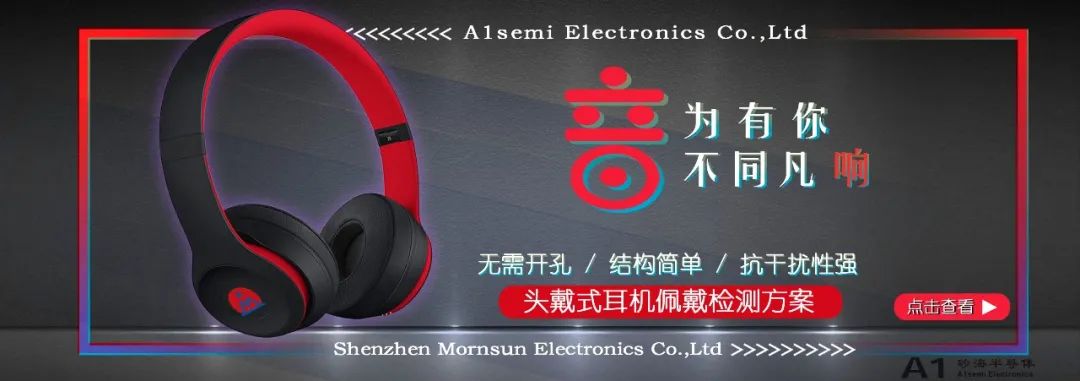
Performance Rivals PS5, Tesla Creates the Strongest In-Car System in Mass Production.
After using AMD’s CPU and GPU, Tesla has created the strongest in-car system, outperforming even the laptop you have.
Recently, the domestic Tesla Model Y Performance version officially began delivery. Observant owners noticed that the Model Y Performance version has a completely different in-car system configuration compared to Tesla’s other domestic models—Model 3 series, Model Y, and Model Y Long Range, featuring an AMD Ryzen processor. This configuration is almost identical to the Model S, which has not yet been introduced domestically.
This means that Tesla has brought desktop PC computing power into the car, and this powerful smart cockpit hardware is once again leading the wave of automotive intelligence.
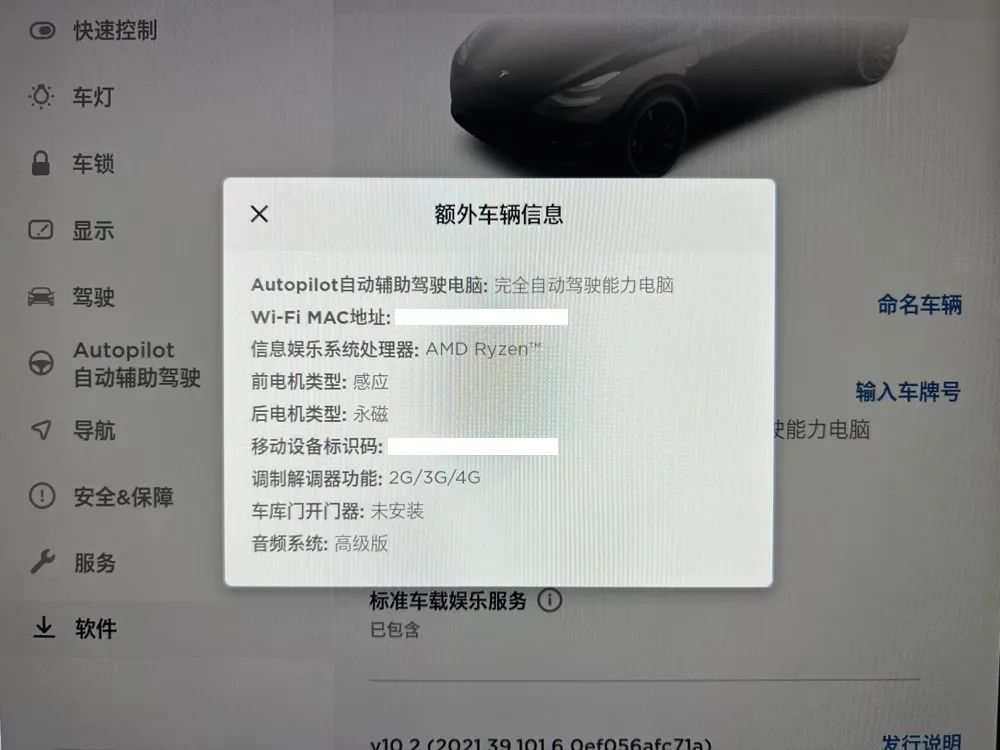
▲ Tesla Model Y equipped with AMD Ryzen processor
Disassembly images show that the Tesla Model Y Performance version not only uses the AMD Ryzen processor but also features an independent graphics card from AMD, which has single-precision floating-point performance comparable to that of the Sony PlayStation 5.
With Tesla demonstrating gameplay of Cyberpunk 2077 in the car, rendering images of AAA games like The Witcher 3, it is likely that Tesla will become a mobile supercomputer in the future. Besides gaming, Tesla can generate larger-scale revenue through software and services.
This will become a significant growth point beyond Tesla’s core vehicle manufacturing business.
So, how powerful is the new in-car domain controller equipped in the Tesla Model Y Performance version compared to the Model S? Can it compete with the gaming performance of a PC or Sony PlayStation 5? Through disassembly of Tesla’s cockpit domain controllers both domestically and internationally, we can see the internal components of the domain controller, unveiling the mystery of this powerful machine.

Equipped with AMD Hardware: In-Depth Analysis of the Strongest In-Car System in Mass Production
Disassemblies by xiaote.com and YouTube blogger Ingineerix allow the outside world to see the in-car system of the Model Y Performance version and the new Model S. Overall, the differences between the two are minimal, with the main chip configurations being identical, but there are some differences in interfaces and RAM memory configurations.
From the disassembly images, both in-car entertainment domain controllers use liquid cooling, and there are no moving parts like fans inside the domain controller.
1. Equipped with AMD CPU + GPU
By opening the covers of the two domain controllers, one can see the mainboard of the in-car entertainment system. The mainboard of both the Model Y Performance version and the Model S features an AMD Ryzen embedded processor, with the largest chip on the right side identified as the AMD Ryzen embedded processor, numbered YE180FC3T4MFG.
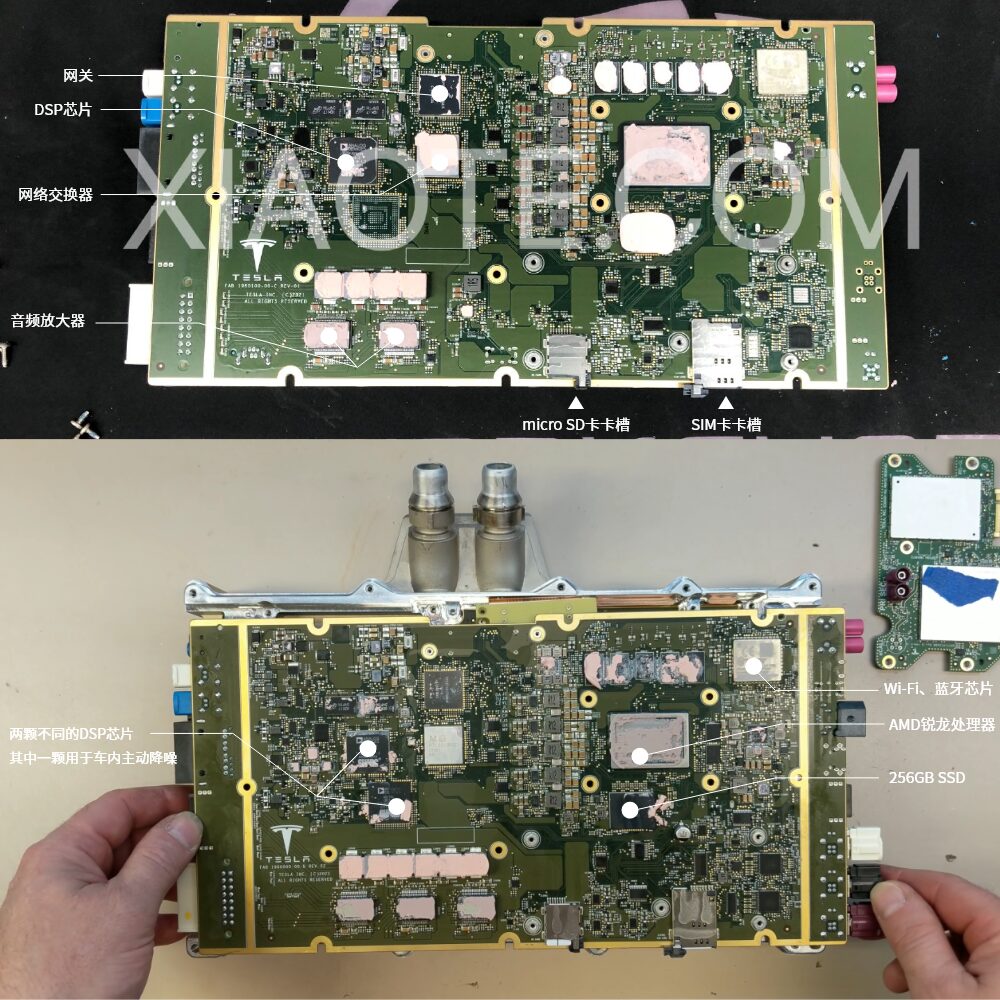
▲ The Model Y Performance version and Model S equipped with the third-generation cockpit controller
According to the AMD naming rules summarized by Reddit users, “YE” stands for Ryzen Embedded, meaning it is an embedded processor. “180” indicates that this processor belongs to the embedded V1000 series, while “F” has not been explained yet. The subsequent “C3” indicates a TDP of 45W. “T” signifies that the chip’s physical package is FP5 BGA. “4M” indicates that this chip has a 4-core CPU and features 4x512KB of L2 cache and 4MB of L3 cache. The “FG” suffix indicates that the processor’s code name is Picasso, meaning it is manufactured using a 12nm process by GlobalFoundries.
In AMD’s list of embedded processors, there are no products corresponding to this model or specifications; AMD’s official website shows that the embedded processor used by Tesla meets the AEC-Q100 standard. Based on previous analyses, the embedded processor used by Tesla is similar to the Ryzen V1404I, as only this processor can operate in environments ranging from -40°C to 105°C. Unlike the V1404I, the embedded processor used by Tesla may have an increased base frequency.
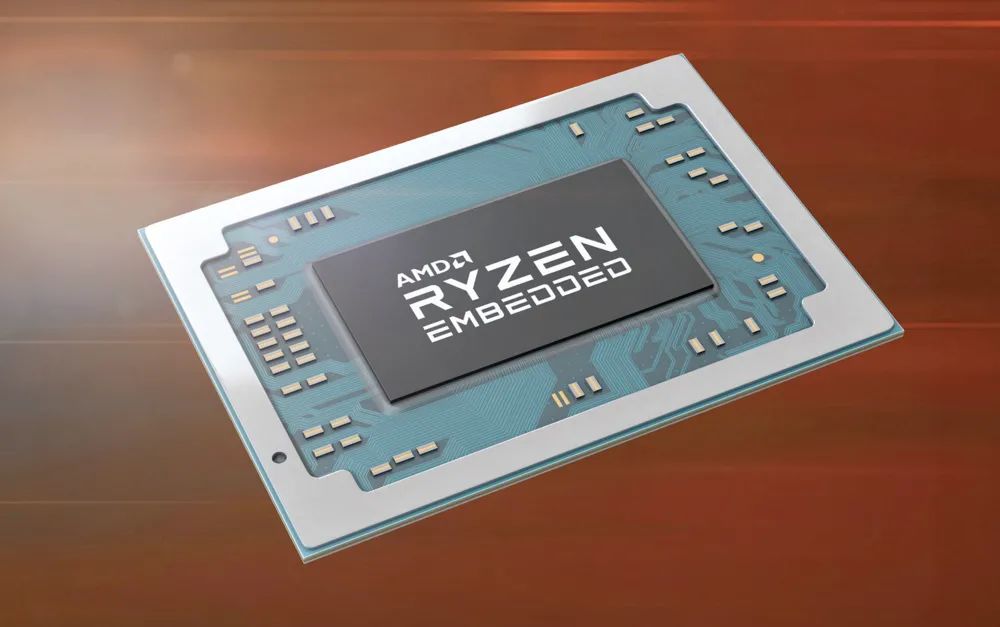
▲ AMD Ryzen embedded processor
The embedded processor used by Tesla also integrates a graphics card, possibly the Vega 8. This integrated graphics card can drive the central control screen, instrument panel, and rear screens inside the car.

▲ Independent graphics card in the Tesla Model S cockpit domain controller
Below the mainboard, connected via PCIe is the RDNA 2 architecture graphics card. When AAA games are launched, this graphics card can perform its function. From the disassembly images, its model is labeled as 215-130000026, with a computational performance of approximately 10TFLOPS, which is very close to the computational performance of the Sony PlayStation 5 and also similar to the AMD Radeon PRO W6600 graphics card (referred to as W6600).
The W6600 graphics card is built on TSMC’s 7nm FinFET process, featuring 28 compute units and 1782 stream processors, capable of achieving a peak performance of 10.4TFLOPS in single-precision floating-point operations, which is very similar to the graphics card equipped in Tesla.

The Tesla graphics card is also equipped with 8GB of GDDR6 memory, with the memory chips sourced from Samsung, consistent across both the Model S and Model Y.
From the analysis above, the AMD Ryzen embedded processor used by Tesla should outperform the V1404I. Based on CPU Benchmarks performance tests, it can be inferred that the AMD Ryzen embedded processor used by Tesla is likely stronger than Intel’s 4th to 7th generation i7 4-core laptop processors, such as the i7-4700HQ, a configuration that is not considered top-tier today.
This may be because automotive chips need to meet stringent automotive track requirements, such as high and low-temperature shocks, vibrations, and electromagnetic interference, so the performance of automotive chips often lags behind that of consumer electronics.

▲ Desktop graphics card ladder chart from Driver Home
The independent graphics card used by Tesla is close to the Radeon Pro W6600, outperforming the consumer-grade Radeon RX6600. According to the desktop graphics card ladder chart from Driver Home, the independent graphics card equipped in Tesla is positioned relatively high-end.
2. Model Y’s cockpit controller has larger memory
On the front of the mainboard of both models, beneath the Ryzen embedded processor, is a Micron memory chip with a capacity of 256GB. Compared to the previous generation’s 64GB eMMC, there is a significant improvement in both capacity and read/write speed.
On the front right side of the mainboard, there are several RAM chips, but the configurations of the Model S and Model Y Performance version are not the same, with the Model Y Performance version having even higher configurations.

▲ Memory chips in the Tesla Model S domain controller
The disassembly images of the Model Y Performance version show that its mainboard has a total of 8 RAM chips on both sides, sourced from Micron. In the disassembly images of the Model S, there are a total of 10 RAM chips on both sides, also sourced from Micron.
This is the biggest difference in the in-car entertainment systems between the Tesla Model Y Performance version and the Model S.
According to the analysis of the memory chips, the memory chips in both models are different, and their capacities also vary. In the Model S, there are two types of memory chips, where 8 chips have the FBGA code D9XSM, corresponding to a capacity of 8GB, and the other 2 chips have the FBGA code D9XSP, corresponding to a total capacity of 2GB, totaling 10GB. The memory in the Model Y Performance version has the FBGA code D8BHQ, corresponding to a capacity of 16GB.
3. Model S has more features, interfaces, and richer chips
On the in-car computers of the Model S and Model Y Performance version, there are some chip configurations that differ. For example, the motherboard of the Model S is equipped with two DSP chips, one for audio processing and the other for active noise cancellation inside the car. The Model Y does not have active noise cancellation, thus it has one less DSP chip.
Additionally, the Model Y Performance version has only one screen inside, so the screen sequence chip on the bottom right of the mainboard is also just one, which is fewer compared to the Model S.
In terms of interfaces, the Model Y Performance version has significantly fewer interfaces compared to the Model S. This is also because the Model Y has only one display screen, while the Model S has three screens, thus offering more functionalities.
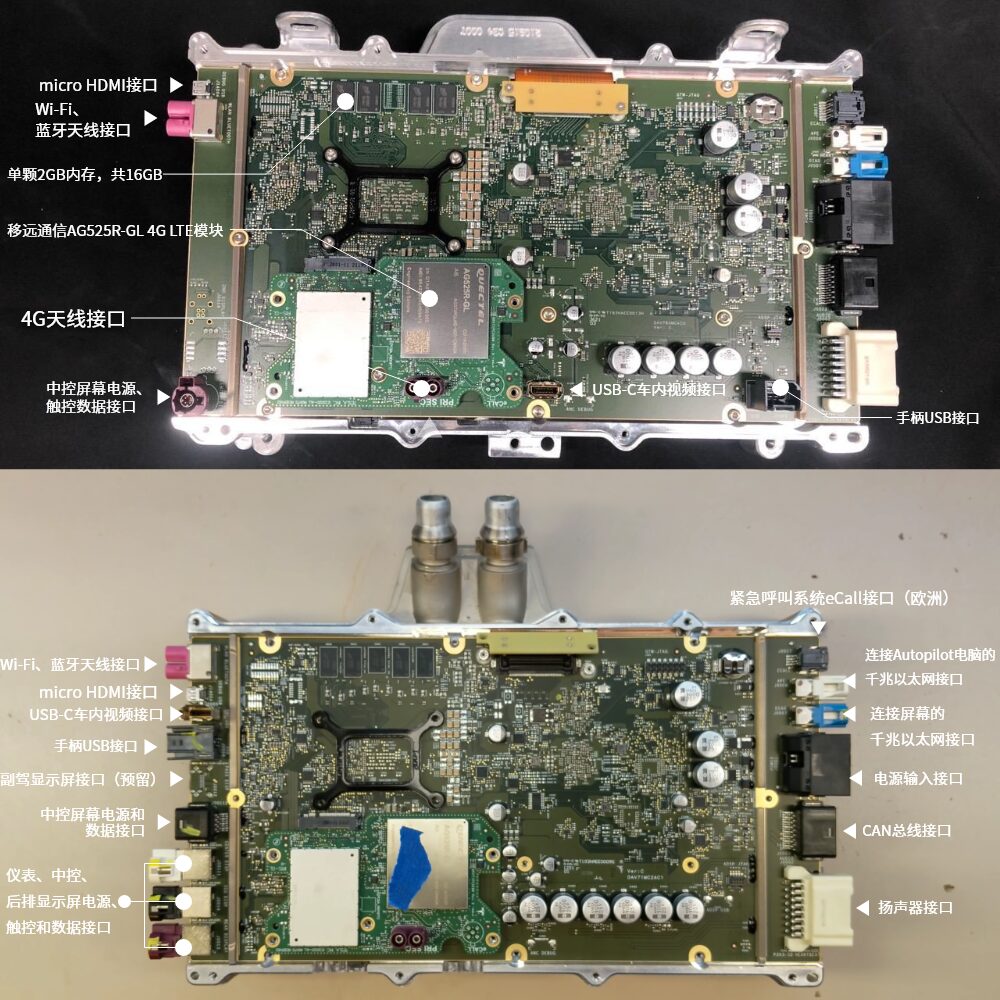
▲ The third-generation cockpit controllers of the Model Y Performance version and Model S
Looking at the disassembly images of the Tesla Model S in-car system, there are a total of eight interfaces on the left side, plus one hidden interface. At the top are the Wi-Fi and Bluetooth antennas for wireless connectivity in the car. Next is the micro HDMI for outputting video signals, a USB-C interface for inputting signals from in-car cameras, and a USB interface for connecting game controllers or USB drives. The bottom four interfaces are the connection lines for the instrument panel, central control, and rear screens.

▲ The Tesla Model S has a total of three screens inside
In the center of the interface row, Tesla has reserved one interface position, which is said to be usable if there is a screen in front of the passenger seat. Both the new Model S and Model Y Performance version have reserved one interface space, which can be seen as a little Easter egg from Tesla.
On the right side of the mainboard, there are a total of 6 interfaces, which are identical for both the Model S and Model Y Performance version. The top is the emergency call system eCall interface, which can be used in Europe, followed by a gigabit Ethernet interface for connecting to the Autopilot computer, possibly for transmitting video data and rendering it on the in-car display. Below is another gigabit Ethernet interface for connecting to the screen, a power input interface, a CAN bus, and a speaker interface.
The vehicle’s 4G network module is connected to the mainboard, and it can be seen that the supplier is the Chinese company Quectel, with the model AG525R-GL, supporting a maximum 4G network speed of 600Mbps.
Tesla’s cockpit has completely changed its “core”; the first goal is to eliminate lag in the in-car system, and the second is to significantly enhance gaming performance, capturing people’s time in the car through gaming, with gaming performance being the largest upgrade.
Smooth Real-World Experience: AAA Games Not Yet Available
Since the first delivery in 2013, Tesla’s cockpit domain controller has evolved to the third generation, and this upgrade has resulted in more than a 50-fold increase in GPU single-precision floating-point performance. In actual experience, the speed of opening applications and loading web pages has noticeably increased.
1. Actual Experience is Smoother
In actual vehicle testing, the Tesla Model Y equipped with the AMD Ryzen processor had a cold start loading time of 20 seconds for Tencent Video, 9 seconds for Bilibili, 9 seconds for the game Eagle’s Pride, and 4 seconds for the browser.
Even the frequently used map function operates more smoothly with the new in-car system, without any unexpected lag.
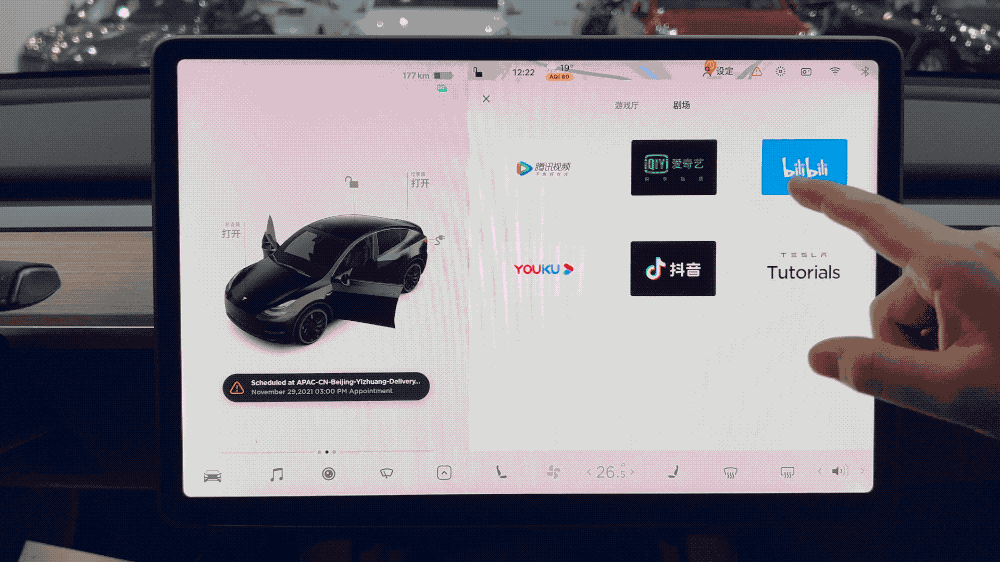
▲ Tesla Model Y Performance version opening Bilibili
Compared to mobile phones, the loading speed of the Tesla in-car system is still relatively slow, but it has significantly improved compared to Tesla’s second-generation in-car system.
Actual tests show that the loading times for Tencent Video and Bilibili in Tesla’s second-generation in-car system exceeded 20 seconds, and zooming in and out on maps often resulted in lag, with web browsing frequently causing the screen to lag behind finger movements until reaching the top of the screen.
Car and Things learned from Tesla owners that they indeed experienced noticeable lag when using the previous generation in-car system, and the lag eliminated the excitement that the functions of Tencent Video, Bilibili, and games initially brought them.
2. Two Main Reasons for Lag in the Previous Two Generations of In-Car Systems
The main computing chip of Tesla’s second-generation cockpit domain controller was the Intel automotive-grade processor Atom A3950, which used an integrated graphics card, and the flash memory used was the relatively slow eMMC, both of which contributed to the lag in the in-car system.
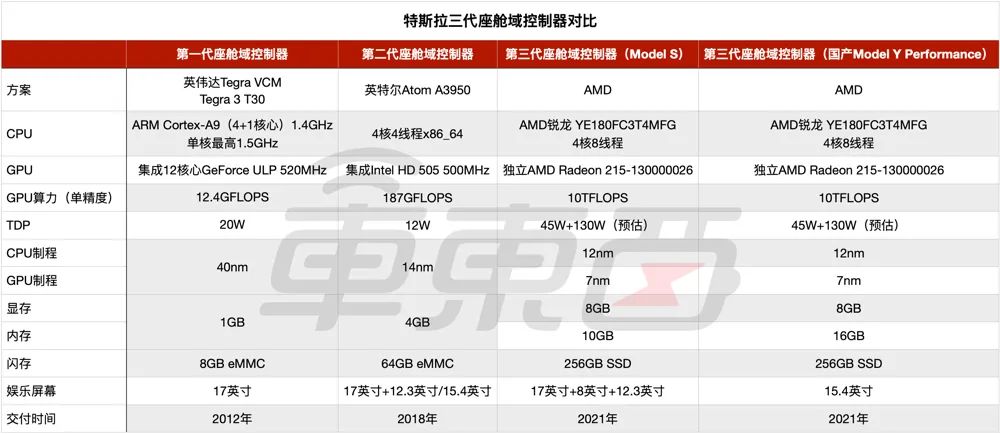
▲ Comparison of Tesla’s third-generation cockpit domain controller
The main computing chip, Intel Atom A3950, was released in the fourth quarter of 2016 and is a 14nm process chip with a 4-core, 4-thread CPU and an integrated Intel HD 505 graphics card. This graphics card configuration can be described as a “boot-up card,” with a computational power of approximately 187GFLOPS.
The well-known processor evaluation website NotebookCheck rated the Intel HD 505, stating that even games from 2016 struggled to run smoothly, even at the lowest graphics settings.
Tests on the website showed that Assassin’s Creed Odyssey had a frame rate of 1 frame at 720P resolution, while Need for Speed 20 had a frame rate of 2 frames at 720P resolution, making it impossible to play AAA games, although mobile games ported over were still playable.
The Tesla second-generation cockpit domain controller equipped with the Intel Atom A3950 was first released with the Model 3 in 2018. At that time, this processor was sufficient, as the functionalities of smart cars were still relatively few, and features like maps, videos, web browsing, and simple games excited consumers since traditional cars had not been designed in this way.
In addition to the weak performance of the processor and integrated graphics card, the 64GB eMMC used in the Tesla in-car system may also be another reason for the lag.
eMMC, compared to mechanical hard drives, has significantly improved read speeds and vibration stability, making it common in early electronic devices. However, it also has obvious drawbacks, particularly its lifespan.
Due to cost constraints, some eMMCs may have a write and erase lifespan of only a few hundred cycles. With daily fixed write and erase operations in a car, eMMC could fail after a few years of use. In mobile devices like phones, the replacement cycle is relatively short, so the risk of damage is lower; however, in cars, the replacement cycle reaches 8-10 years, increasing the risk of eMMC failure.
As usage time increases, the read and write speeds of eMMC tend to slow down, with the most direct experience being lag.
Now, Tesla’s third-generation cockpit domain controller has replaced the previous eMMC with an SSD, with no significant change in cost, but with a noticeable increase in read/write performance and lifespan.
Compared to Tesla’s first-generation cockpit domain controller, the third-generation is clearly from a different era and has long been completely eliminated by Tesla. The Tegra 3 T30 chip used in the first generation is comparable in performance to Apple’s Watch S5 chip, and is clearly insufficient for an in-car system.
Earlier this year, the 8GB eMMC used in the first-generation cockpit domain controller was recalled by Tesla due to the fact that after 7-8 years of use, the in-car system became slower and even failed.
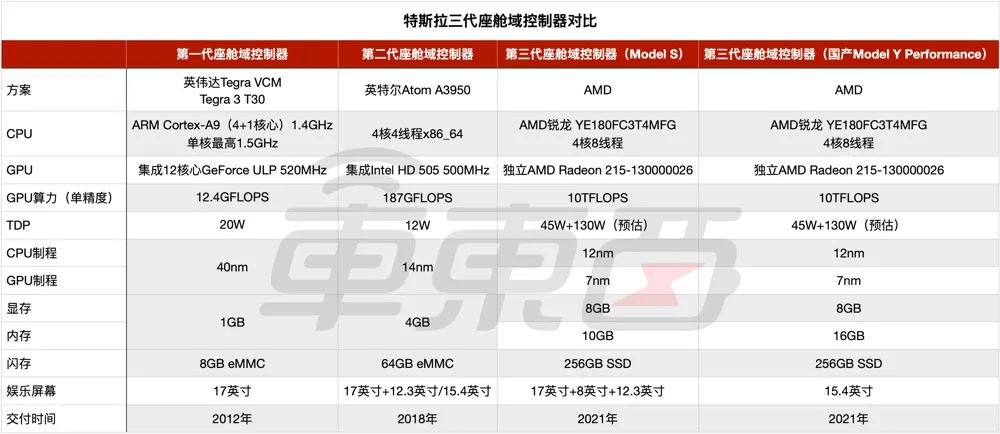
▲ First-generation cockpit domain controller of Tesla
Compared to the first-generation cockpit domain controller, Tesla’s second-generation cockpit domain controller saw a significant improvement in processing performance, with quantifiable GPU single-precision floating-point performance increasing by 15 times. From the second to the third generation of cockpit domain controllers, the upgrades are even more “terrifying”, with the measurement units upgrading from GFLOPS to TFLOPS, increasing by more than 53 times.
Although the increase in single-precision floating-point performance does not directly correlate with the frame rates of games, currently, there are no AAA games that can truly leverage the capabilities of the third-generation cockpit domain controller. However, this upgrade has indeed placed Tesla at the top of the smart in-car system realm.
Tesla Leads the Development of Smart Cars, Creating Greater Imagination Space
The wave of intelligence has already swept through the entire automotive industry, and the performance competition of smart in-car systems is becoming increasingly fierce. Tesla’s latest cockpit controller not only crushes all current mass-produced vehicles in performance but also remains ahead of the latest chips set to be released in 2023.
Just last week, Baidu, Jidu, and Qualcomm announced that Jidu’s first vehicle will adopt Qualcomm’s fourth-generation Snapdragon automotive digital cockpit platform premium chip—the Qualcomm SA8295P. Its CPU uses the same generation of the sixth-generation Kryo CPU as the Snapdragon 888, and the GPU’s 3D rendering performance is three times better than the 8155 chip, with an AI computing power of 30TOPS.
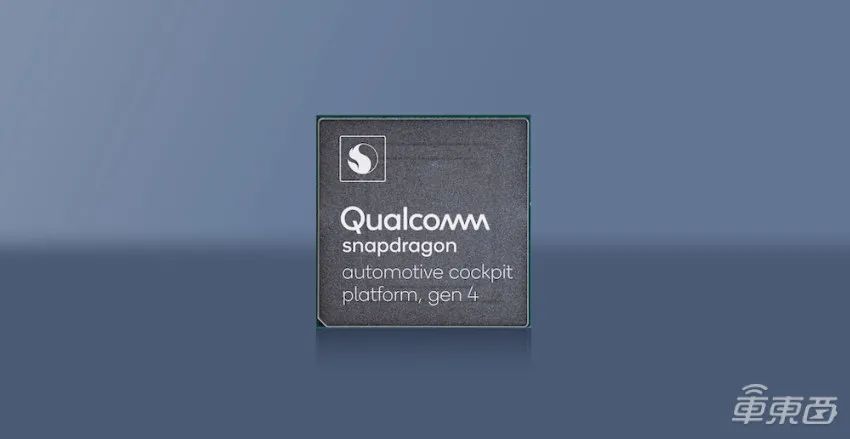
▲ Qualcomm’s fourth-generation Snapdragon automotive digital cockpit SoC
According to predictions, the GPU computing power of the 8295 chip will exceed 3000GFLOPS, which still shows a significant gap compared to Tesla’s third-generation cockpit domain controller with 10TFLOPS. Moreover, Qualcomm’s 8295 chip will not be mass-produced until 2023, which is nearly 2 years later than Tesla’s third-generation cockpit domain controller.
Currently, smart cars are still in the early stages of development, and the industry is still exploring the development direction of smart cockpits. However, from Tesla’s current approach, it is evident that they are attempting to integrate PC-like computing power into cars, using x86 architecture CPUs and Linux operating systems to run AAA games like Cyberpunk 2077 and The Witcher 3, and potentially running desktop applications for office and email in the future, providing more imaginative space for smart cockpits.
In June of this year, the new Tesla Model S began delivery, and Musk showcased the powerful performance of the third-generation cockpit domain controller during the delivery ceremony. At the event, Tesla staff used a controller to play Cyberpunk 2077 directly on the in-car system, astonishing the global audience watching the live stream.

▲ Tesla demonstrates playing Cyberpunk 2077 in the car
Meanwhile, the interior renderings of the new Model S also featured games like The Witcher 3, continuously enhancing Tesla’s gaming attributes.
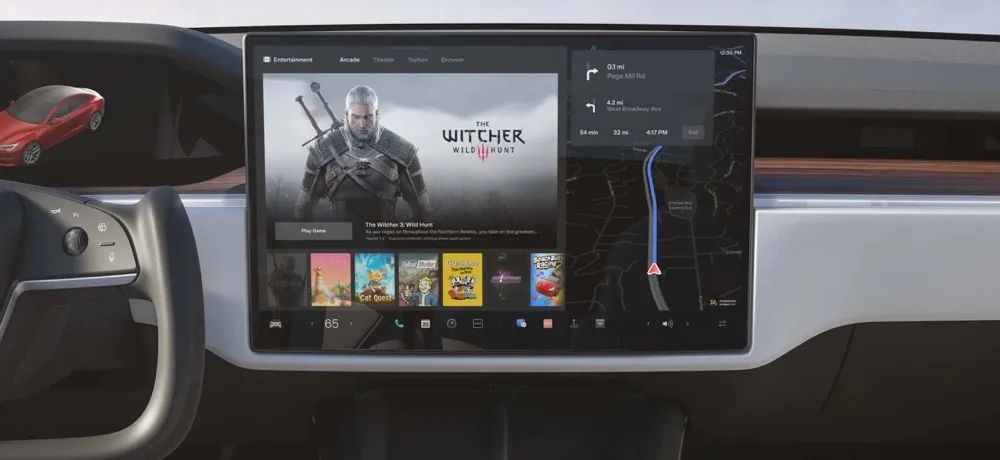
▲ The Witcher 3 game on Tesla Model S in-car system
When cars become computers on four wheels, automakers can create greater value through software.
For example, in the gaming industry, the ruling in the Epic Games vs. Apple case shows that about 70% of the revenue from Apple’s App Store comes from games. Moreover, Apple’s software services have a gross margin exceeding 70%. This means that if Tesla can create a software platform similar to Apple’s App Store in the automotive field, the cost of large-scale software replication is almost zero, and the gross margin could easily surpass that of vehicle manufacturing, becoming a significant growth point for Tesla beyond vehicle manufacturing.
In fact, Tesla has long been laying the groundwork for software purchases and subscription models. For example, Tesla has launched a subscription model for Full Self-Driving (FSD) capabilities in the U.S., allowing users to subscribe for $199 per month (approximately 1268 RMB) instead of paying $10,000 (approximately 63700 RMB) outright.
In the future, as Tesla’s in-car software and gaming ecosystem gradually take shape, the experience of using software in the car will resemble how we use PCs to play games and purchase software today.
If we look further ahead, if Apple launches autonomous driving vehicles after 2025 and seamlessly integrates the App Store into the in-car system while transplanting the strongest M-series chips into the smart cockpit, can it compete with Tesla? The answer is very difficult.
The reason is that the AAA game ecosystem on Apple’s macOS platform is not well developed. Even with seamless integration, it may still struggle to compete with Tesla’s Linux platform.
This further proves that with the powerful hardware of the third-generation cockpit domain controller, Tesla has sufficient capability to create a strong application store in the automotive field. After integrating entertainment, gaming, and functional software, the intelligence of Tesla’s cockpit will reach a new level.




































